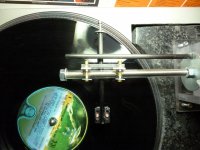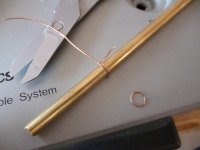I tend to disagree, rigidity can have very little to do with effective mass. With the choice of material we have nowadays we can have rigidity with very little effective mass, even the cf tube I use @ 6" this translates into just over 3 grams at .5 grams an inch. You can build a very light carriage and end up with high rigidity dependant on where you place the mass, hanging the mass is the most rigid option. Lets not forget here that we also have to factor in cartridge compliance, a 10 gram arm simply by the laws of physics will not sound or work well with an MC and its low compliance. One easy method of determining the arms potential is if you have a frequency sweep record, try it out and run a 20k to 20hz sweep and listen for anomalies, this will let you know where resonant peaks are, the goal is to get it to play the bands consistent top to bottom with no peaks, hf resonance will easily show itself and almost double the perceived volume. This latest arm will do the whole sweep with no peaks, and firm bass down to 20hz. Any pivoted arm with any bearing slop will fall flat after about 50hz, hence the rigid but free bearing will trace well across the band deep into the very quietly cut bass frequency on the vinyl.
Colin
Colin
Tracking Problems
I am up an running. I have no way of measuring the tracking force. I have tried moving the counter weight about . The carriage will not advance along the tube. Tried trumpet valve oil. Will it be the cartridge alignment?????Any ideas
I have not attached cable yet
I am up an running. I have no way of measuring the tracking force. I have tried moving the counter weight about . The carriage will not advance along the tube. Tried trumpet valve oil. Will it be the cartridge alignment?????Any ideas
I have not attached cable yet
Hello chokesrule
Did you used that oil because it has to do with music? 🙂 Just kidding.
Are the ball bearings shielded? If they are, they are most likely greased.
Look at Clear Audio's linear tone arms. They use open bearings.
The tone arm I built in 2012 would not work at first until I removed the grease from the bearings. I couldn't afford to buy new bearings so I soaked them in a circuit board cleaner in a sealed glass vial. Once the grease was removed, The tone arm worked just fine.
I would never lubricate bearings in this type of application.
Sincerely,
Ralf
Tried trumpet valve oil
Did you used that oil because it has to do with music? 🙂 Just kidding.
Are the ball bearings shielded? If they are, they are most likely greased.
Look at Clear Audio's linear tone arms. They use open bearings.
The tone arm I built in 2012 would not work at first until I removed the grease from the bearings. I couldn't afford to buy new bearings so I soaked them in a circuit board cleaner in a sealed glass vial. Once the grease was removed, The tone arm worked just fine.
I would never lubricate bearings in this type of application.
Sincerely,
Ralf
Well, in an ideal mechanical world the cartridge could be affixed without any vertical pivot, and a horizontal carriage with nil friction and ideal damping...
So, to interpret what is being said here, the "Bo" method or concept apparently is to come close to this ideal. The means by which this is done is via a two threshold vertical pivot in the form of a ball bearing.
When ideally seated at the perfect height above a perfectly flat record the ball bearing sits perfectly in its race. Nothing moves except for the stylus. Next threshold is when there is slight vertical motion either due to a variation in LP thickness or a slight warp in the surface. This is covered by the rotation of the inner race WRT the outer race by the balls in the bearing. Presumably this is a very small amount of movement, but since there is a lever (the arm) very little movement at the bearing is more at the stylus end. Next threshold is when the small rotation in the bearing is exceeded, then the entire assembly is forced to move on the surface of the rod.
It is interesting to note that there are bearings designed for this sort of rotation, afaik. In that case it would be more like having a vertical pivot in a standard arm - which fwiw folks have said is NG for the sort of performance that this designs features.
The other thought that I had is that I think, but am not sure, that lower grade bearings have more axial slop than high grade bearings. So, is axial slop good (required?) or does one want less axial slop??
Anyhow that is what I think is being suggested with respect to the term "rigidity", it's not (just) the rigidity of the arm wand.
Of course this speaks to another issue, why is this different than merely using a high mass arm?
_-_-
So, to interpret what is being said here, the "Bo" method or concept apparently is to come close to this ideal. The means by which this is done is via a two threshold vertical pivot in the form of a ball bearing.
When ideally seated at the perfect height above a perfectly flat record the ball bearing sits perfectly in its race. Nothing moves except for the stylus. Next threshold is when there is slight vertical motion either due to a variation in LP thickness or a slight warp in the surface. This is covered by the rotation of the inner race WRT the outer race by the balls in the bearing. Presumably this is a very small amount of movement, but since there is a lever (the arm) very little movement at the bearing is more at the stylus end. Next threshold is when the small rotation in the bearing is exceeded, then the entire assembly is forced to move on the surface of the rod.
It is interesting to note that there are bearings designed for this sort of rotation, afaik. In that case it would be more like having a vertical pivot in a standard arm - which fwiw folks have said is NG for the sort of performance that this designs features.
The other thought that I had is that I think, but am not sure, that lower grade bearings have more axial slop than high grade bearings. So, is axial slop good (required?) or does one want less axial slop??
Anyhow that is what I think is being suggested with respect to the term "rigidity", it's not (just) the rigidity of the arm wand.
Of course this speaks to another issue, why is this different than merely using a high mass arm?
_-_-
Chokesrule,
Is the glass tube level ?, and are the bearings riding a spacer with a 4-5mm gap between them inside?.
Colin
Is the glass tube level ?, and are the bearings riding a spacer with a 4-5mm gap between them inside?.
Colin
I think an longer arm would be beneficial, then the angular movement with warps will be less, also the trouble of swinging or other arm removal means for record change will be eliminated.
I don't really see the point in the shorter arms that are used by clear-audio, and also in this design. apart from the weight element, that can be handled by the use of thinner walled carbon shafts, maybe a destruction of a carbon badminton racket could pose for both the head-shell and the arm-shaft.
I don't really see the point in the shorter arms that are used by clear-audio, and also in this design. apart from the weight element, that can be handled by the use of thinner walled carbon shafts, maybe a destruction of a carbon badminton racket could pose for both the head-shell and the arm-shaft.
Miib,
It's not the weight of the armtube that is the factor wholly, it is the weight of the cartridge, as the tube gets longer more countering weight is need to balance it out, thus adding mass.
Colin
It's not the weight of the armtube that is the factor wholly, it is the weight of the cartridge, as the tube gets longer more countering weight is need to balance it out, thus adding mass.
Colin
Straight Tracker
I think your right...It seems to be working but its taken a lot of work to clean away the grease. I got to get the cable next and tidy the counter weight and get some scales .
I think your right...It seems to be working but its taken a lot of work to clean away the grease. I got to get the cable next and tidy the counter weight and get some scales .
Attachments
The only thing I see there is that the outer washers look to be contacting the outer race of the bearings. That will cause ALOT of friction. The washers should only contact inner race.
I understand the geometric issues which are still there with a longer arm to a lessened degree. I brought up mass but at the same time friction is greater due to increased side force with a longer arm, it's all relative simple physics. In the end there are always trade offs, it just depends what you are willing to live with. I for one am into having it track well. And maintain tangency
with rigidity .,we could squabble about theoretical notions all day but until the ideas are applied to trial and error and proof of concept the advances are just ego feeding hash at best 🙂. It is fabulous to see however thosebuilding and honing the ideas out there .🙂.
Colin
with rigidity .,we could squabble about theoretical notions all day but until the ideas are applied to trial and error and proof of concept the advances are just ego feeding hash at best 🙂. It is fabulous to see however thosebuilding and honing the ideas out there .🙂.
Colin
I second SGregory's observation, only the inner races can have contact with the mounting system. It appears from the photo that the bearing is not free to rotate. Simple fix.
Bear is right , that's why to220 top hats work best, they only contact the inner race. You want just enough lip to keep the bearings from sliding off, then the systems will function flawlessly. Both bearings must be set this way on each underside.
Colin
Colin
Well, in an ideal mechanical world the cartridge could be affixed without any vertical pivot, and a horizontal carriage with nil friction and ideal damping...
So, to interpret what is being said here, the "Bo" method or concept apparently is to come close to this ideal. The means by which this is done is via a two threshold vertical pivot in the form of a ball bearing.
When ideally seated at the perfect height above a perfectly flat record the ball bearing sits perfectly in its race. Nothing moves except for the stylus. Next threshold is when there is slight vertical motion either due to a variation in LP thickness or a slight warp in the surface. This is covered by the rotation of the inner race WRT the outer race by the balls in the bearing. Presumably this is a very small amount of movement, but since there is a lever (the arm) very little movement at the bearing is more at the stylus end. Next threshold is when the small rotation in the bearing is exceeded, then the entire assembly is forced to move on the surface of the rod.
It is interesting to note that there are bearings designed for this sort of rotation, afaik. In that case it would be more like having a vertical pivot in a standard arm - which fwiw folks have said is NG for the sort of performance that this designs features.
The other thought that I had is that I think, but am not sure, that lower grade bearings have more axial slop than high grade bearings. So, is axial slop good (required?) or does one want less axial slop??
Anyhow that is what I think is being suggested with respect to the term "rigidity", it's not (just) the rigidity of the arm wand.
Of course this speaks to another issue, why is this different than merely using a high mass arm?
_-_-
Bear, Good summary. Early on, back in the Cantus thread. I discussed the amount of radial play aka axial slop with a bearing supplier. He confirmed that abec 7 bearings had less radial play than abec 1. So the logical assumption is that the more radial play the bearing has the greater warp the arm will track. What has been challenging me is why the Cantus configuration wants dry bearings whilst the 4 bearing on top of the tube wants a lightly lubricated (not greased) bearing. As near as I can see the axial alignment of the bearings in the 4 bearing design prevents radial play in the inner bearing races from taking place at all. This will keep the balls rolling in the best position in the inner and outer races, hence less rolling friction than would be present in the two bearing design where the inner races can be cocked one way or the other with possibly more friction. The 4 bearing carriage depends on the bearings "sliding" on the tube surface around the outside for vertical motion, even the smallest. Whilst this is intuitively bad, in practice we see the arm tracking warps and having very fast recovery time.
imho the 2 bearing design, because of radial play, works against Bo's goal of achieving a rigid system for best information retrieval. Conversely the alignment of the 4 bearings actually achieves more rigidity and less rolling friction. From what 4 bearing carriage builders report this appears to be the case.
BillG
Bear is right , that's why to220 top hats work best, they only contact the inner race. You want just enough lip to keep the bearings from sliding off, then the systems will function flawlessly. Both bearings must be set this way on each underside.
Colin
Colin
Hi
I've been looking for top hats everywhere but can't seem to source them. Does anyone know of a supplier in the UK?
Thanks
I've been looking for top hats everywhere but can't seem to source them. Does anyone know of a supplier in the UK?
Thanks
same problem...going to wrap a 1mm thick or smaller length of copper wire around the brass tube to keep the washer off the bearing.
Or a 5mm eyelet on ebay might work
Or a 5mm eyelet on ebay might work
Last edited:
- Home
- Source & Line
- Analogue Source
- DIY linear tonearm



